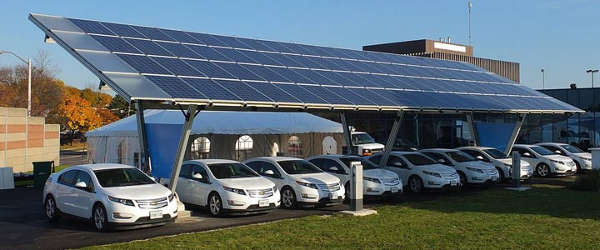- Michigan Technological University engineers look into the untapped potential of parking lots.
- They investigate the energy-related benefits of developing charging stations powered with solar canopies built into the parking infrastructure of large-scale retailers.
The number of people who own electric vehicles (EVs) is increasing, but they face a conundrum: Unlike those who own gasoline-burning cars, EV owners can’t just pop down to the corner gas station for a fill-up. Particularly in rural areas, charging stations can be few and far between.
Joshua Pearce, Richard Witte Endowed Professor of Materials Science and Engineering and professor of electrical and computer engineering at Michigan Technological University, hopes to change that.
In a model outlined in a paper in the journal Renewable Energy, Pearce and his co-author, graduate student Swaraj Sanjay Deshmukh, note the untapped potential of retail parking lot solar photovoltaic awnings.
The study investigates the energy-related benefits of developing EV charging stations powered with solar photovoltaic (PV) canopies built into the parking infrastructure of large-scale retailers like Walmart.
The case study shows such canopies could generate a potential of 3.1 megawatts per Walmart supercenter in the U.S., providing solar electricity for approximately 100 EV charging stations. Across the country, Walmart could deploy 11.1 gigawatts of solar canopies over parking lots to provide more than 346,000 EV charging stations with solar electricity for their customers. Such a fleet of solar awnings would cover the needs of 90% of the American public living within 15 miles of a Walmart — just about as prevalent as the corner gas station.
This model could be adopted by any box store because they have a competitive advantage of stand-alone EV charging stations. Solar electricity for EV charging could be made at a profit, solving community charging challenges. The results indicate store owners could increase store selection and profit by providing free PV-EV charging for their customers with four key benefits:
– Increasing customer comfort by providing shading and precipitation shelter.
– A path for green consumerism.
– Incentive for preferential shopping for owners of plug-in hybrid electric vehicles and EVs.
– Increase shopping time and money spent at the store to enable more charging.
“The electric car powerhouse Tesla is now the most valuable automobile company in the world, and the more experienced auto manufacturing giant GM has announced gas and diesel vehicles will be extinct by 2035. It is clear EV growth will continue to accelerate,” Pearce said. “Retailers have an opportunity to leverage the stranded asset of their parking lots for profit from preferential store selection by the growing army of EV owners. Fast-moving retailers that make the investment in solar canopies and EV charging stations will attract early EV adopters and reap the most profit.”
—-
Publication Referenced in the Article:
Swaraj Sanjay Deshmukh, Joshua M. Pearce. Electric vehicle charging potential from retail parking lot solar photovoltaic awnings. Renewable Energy, 2021; 169: 608 DOI: 10.1016/j.renene.2021.01.068









Comments